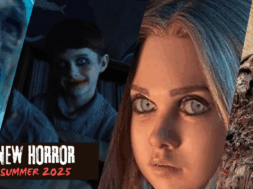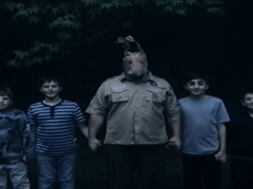This past weekend, Annihilation, Alex Garland’s follow-up to the critically acclaimed Ex Machina was released to an audience still drunk on the juice of purple vibranium flowers (read: Black Panther). Marvel’s newest comic book juggernaut not only topped the box office for the second week in a row, it managed to hold on so well at $108 million that it became the 2nd highest-second weekend ever (behind The Force Awakens). Yes, box office analysts love “records,” however specific they may be. The King of Wakanda wasn’t the only obstacle in Annihilation’s way. There was the new comedy Game Night and the kiddie holdover, controversy-riddled Peter Rabbit (my eyes only roll so far). After the receipts were tallied, Garland’s sci-fi brain melter pulled in around $12 million and settled into the number four spot. Its existence at your local multiplex is likely, itself, to be annihilated after next week.
Why should you give a damn, you may be wondering? The trailers portrayed this as nothing more than another mish-mash of sci-fi and action with some monstrous horror elements thrown in for good measure. Ya know, Aliens? Despite finding the advertising less than captivating, the film was on my radar for a couple of reasons. 1) I stumbled upon a handful of early reviews on Letterboxd claiming the movie was some sort of modern masterpiece. Intrigued. 2) Except for here in the US, Canada, and China the film would not be receiving a theatrical release. A deal was struck with THE streaming platform where difficult Hollywood titles go to “live,” Netflix.
The film is based on a best-selling trilogy of novels and adapted/directed by a man who’s built up mad street cred in the sci-fi world with films like 28 Days Later and Sunshine. It’s easy to see this appealing to Paramount on paper. That’s not even mentioning the amazing cast: Natalie Portman, Jennifer Jason Leigh, Gina Rodriguez and hunk-boat support from Oscar Isaac and David Gyasi. The story of a hardened group of scientists venturing beyond an alien forcefield, braving dangerous mutations in search of answers, seems like an easy sell, too.
Of course, this wouldn’t be the first time a fairly high profile sci-fi thriller with a modest budget got the dump. Apparently, after less than stellar test screenings, Paramount wanted drastic cuts and changes made to bolster the pic’s mainstream appeal. However, Annihilation’s producer, Scott Rudin (Ladybird, Ex Machina), had the power of final-cut to wield against the studio (which is growing rarer in today’s Hollywood climate). Rudin decided to back his filmmaker, and together, they refused to make the requested changes. Paramount was all like, “Well, fine then!” They pushed their $40 million investment off on Netflix. Point and match.
So, was this a similar situation to The Cloverfield Paradox? Early word stated Paramount felt that film was too intelligent for multiplex audiences. Yeah…it wasn’t. Paradox was just a muddy mess of ideas with a built-in “brainy” safety net to excuse all of its poor narrative choices. The likely truth was they just knew a bomb when they saw it. And, let’s face it, Paramount execs have recently had plenty of experience in that department. Was Annihilation going to be more of the same? I needed to find out for myself. Armed with nothing but my MoviePass and a few spare hours, I trekked to the moviehouse, plopped down in the dark of a sparsely filled auditorium, and experienced cinema. Yes, that last part may seem a sniff pretentious, but it’s apropos for the journey this film puts you through.
Obviously, I want you to go SEE the movie, so I’ll keep this relatively spoiler free. Keep in mind, though, some plot points will be discussed vaguely. So, enough of the preamble. Here’s why you should go out and “experience” Annihilation while it’s still in theaters!
Technical Specs
Film is a visual medium, and Annihilation is brought to life with some of the most gob-smackingly gorgeous visuals. The story unveils itself bit by bit as Portman’s Lena recalls the events leading up to her return from beyond the mysterious forcefield known as “The Shimmer.” She doesn’t remember everything. Details are foggy, and as an unreliable narrator, it’s possible not everything we see is a true representation of what actually happened. One thing Lena says, however, does ring exceptionally true. Some of the mutations beyond The Shimmer were horrifying, yet others were beautiful.
The production design on the film is top notch. What begins as “generic movie forest” morphs into overgrown brush of wildflowers – all different types, growing from the same vine. Some grow together into the form of a human, eerily watching our characters as they pass through this new, strange world. The deeper into The Shimmer, the more dangerous things become. And in turn, the more beautiful and abstract. This is a sumptuous experience that draws you in and practically begs you to search every corner of the screen for hidden details. This is what “the big screen” was made for. Better yet, this world is created with an exceptional blend of digital and practical. It would have been easy to take an entire CG paintbrush to the screen, but the impact would have been far less.
The Monsters
The same can be said of the creature effects. There are certain shots where I wasn’t sure if I was looking at latex or pixels. That’s the most difficult magic trick to pull off in film, and they did it. Make no mistake, though, this isn’t a “monster movie” in the traditional sense. But there are terrifying beasts forming within The Shimmer (that weren’t a part of the original source material). While these animals may not be the focus of the story Garland is trying to tell, they will surely linger in your imagination (or nightmares) long after walking away from the theater.
A specific scene highlighted in the marketing materials is head-on, white-knuckle horror. One of the mutations has taken on the voice of its victim, trapped in the painful final moments before death. If the promise of a screaming, skull-faced bear doesn’t get your ass to the movies, I’m not sure what will.
The Score
Beyond the cinematography and production design, there is a killer score from Geoff Barrow and Ben Salisbury (both from Ex Machina) that begins with quaint, almost folksy guitar before descending into a maddening wave of droning synth and nails-on-a-chalkboard strings. This is likely the first soundtrack outside of some rando Italian genre picture from the 70s/80s that I will gladly listen to in my car. Though, on second thought, that might not be advisable.
There is a large portion in the final third that plays out with almost no spoken dialogue. The score builds and builds, thrusting the psychedelic images forward. We’re firmly in 2001: A Space Odyssey territory. By the time the lights came up in the auditorium, I was practically stumbling to my car. I felt as if I’d just come out of a deep hypnosis. Powerful filmmaking or binaural beats buried within the film’s score? Maybe both?
Ultimately, I’m not going to call this a masterpiece as many have been quick to label it. I will say, it has the potential to become one. Temper your expectations, as it’s not perfect. Annihilation actually does share one thing in common with The Cloverfield Paradox. They both feature fairly straightforward, catch-all explanations for the overly complicated goings-on of their stories. The difference, in Paradox they use said catch-all as carte blanche to do whatever they want. Here, Garland uses it to open the door to even bigger questions and potential readings of the material. Just like The Shimmer, it can grow and change its meaning over time.
This is bonafide cinematic art on display at your local multiplex. It’s a film that snuck past the head honchos at Paramount, and they’re surely kicking themselves over it now. Show up, and don’t let “dumped to Netflix” become the new direct-to-video! Even if this film weren’t as good as it is, I would still be calling for more people to check it out. It’s important that cinema represents a wide swath of genres and styles.
The truth of the matter is this: Paramount was right! This movie doesn’t belong at “a theater near you!” But, dammit, be glad it’s there, and go buy yourself a ticket.














